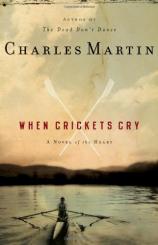Reading Group Guide
Discussion Questions
When Crickets Cry

1. Titles are always important. Why do you think the author chose this one? In Asian countries, the cricket is a symbol of luck and prosperity. What role do crickets play in this story? What do you think about Annie's comment that "they give their lives for mine”?
2. One of the major themes in WHEN CRICKETS CRY is love --- both the nature of love and how it affects people. What are some of the examples of love from the novel (not just romantic love, but also the love of friendship and of sacrifice)? How did each of the characters grow in his or her understanding of love?
3. An obvious symbol for love is the heart, and the author uses this symbol --- doctors who "fix" hearts, people with diseased hearts, characters with "closed" hearts, and don't forget that heart-of-pine house --- to draw our attention to the theme. In addition to love, the symbol of the heart can also be used to represent life itself, compassion or the center of wisdom. How are these different aspects of the heart reflected in Reese's life throughout the story?
4. When we first see Annie, she is wearing a yellow dress and selling lemonade. Considering that yellow is a common symbol of the sun and sunlight, what do you think the author wants us to think about Annie's role in the novel?
5. Another important theme in this novel is the concept of redemption. Who needs a second chance in this story? Who offers one? Does it seem as if each major and minor character falls on both sides of the equation --- both needing redemption and yet somehow able to offer it to someone else?
6. As in all of Charles Martin's novels, water is a recurring motif in WHEN CRICKETS CRY. From the Tallulah River flowing into Lake Burton, to the leaking water pipe, a few rainstorms, and a recurring dream in which Emma pours water from a pitcher, this novel is full of water. Water is often thought of as a symbol of new life --- such as when the spring rains bring the landscape to life with new growth and color. Discuss the ways that water represents both life, and new life, in the story.
7. Boats are another powerful and evocative symbol in the novel. Reese spends time on the lake rowing, and he also builds little "toy" boats --- it's no accident they call to mind a Viking funeral --- to dispose of Emma's letters. Boats can represent a journey, a crossing, adventure and exploration; discuss how each of these relate to Reese's progression through the story.
8. Several things in this story have been buried, starting with the town that is "buried" under the lake that Reese lives next to. What else is buried in this novel?
9. Sometimes it seems as if Reese is hiding behind his literary allusions, holding his emotions at arm's length. From Donne's "No man is an island" and the castaway in ROBINSON CRUSOE, to Shakespeare's "I will wear my heart upon my sleeve…I am not what I am," the author is giving us clues as to Reese's inner feelings, feelings he is often unwilling to give free rein to. The quotations are also used to foreshadow events in the story. Which reference did you find most meaningful? Why?
10. Discuss the meaning of the scripture on Emma's medallion ("Above all else, guard your heart, for it is the wellspring of life; Proverbs 4:23"). What is the significance of Reese's deciding to give the medallion to Annie?
11. Blindness is a symbol that appears in WHEN CRICKETS CRY. Emma's brother, Charlie, is blind, and Helen Keller is both referred to and quoted frequently. Blindness can represent ignorance, darkness, and error --- or a refusal to see reality. It can also represent inner vision (as Hellen Keller said, "the best and most beautiful things in the world cannot be seen or even touched, they must be felt with the heart"). Who is blind in this story, and who can see?
12. Why do you think that Reese avoided reading Emma's last letter? Would you have saved it as he did?
13. What do you think Reese whispered to Annie's heart?
When Crickets Cry
- Publication Date: April 4, 2006
- Genres: Fiction
- Paperback: 352 pages
- Publisher: Thomas Nelson
- ISBN-10: 1595540547
- ISBN-13: 9781595540546








